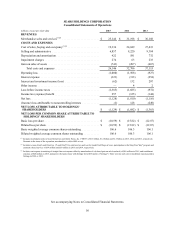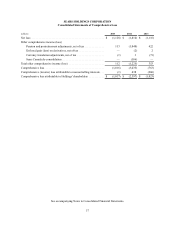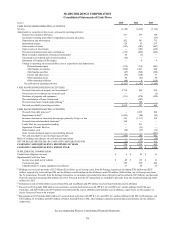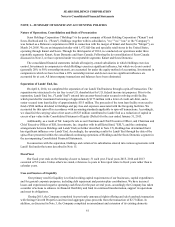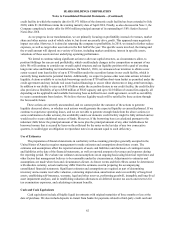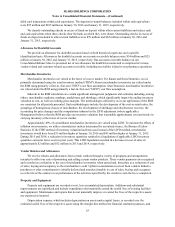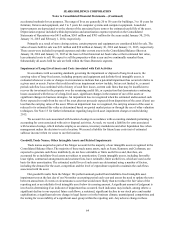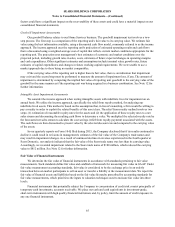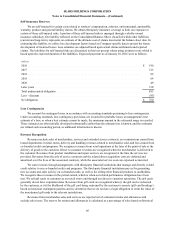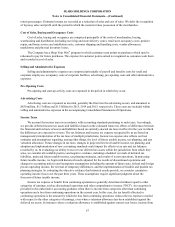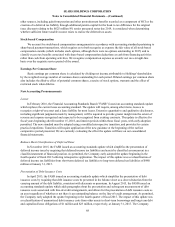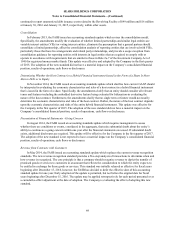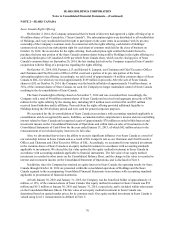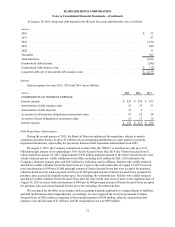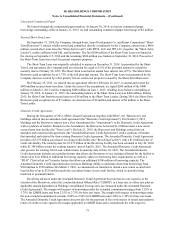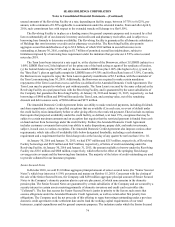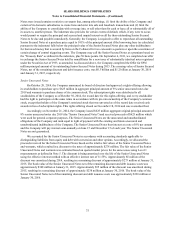Sears 2015 Annual Report Download - page 65
Download and view the complete annual report
Please find page 65 of the 2015 Sears annual report below. You can navigate through the pages in the report by either clicking on the pages listed below, or by using the keyword search tool below to find specific information within the annual report.
factors could have a significant impact on the recoverability of these assets and could have a material impact on our
consolidated financial statements.
Goodwill Impairment Assessments
Our goodwill balance relates to our Home Services business. The goodwill impairment test involves a two-
step process. The first step is a comparison of the reporting unit's fair value to its carrying value. We estimate fair
value using the best information available, using a discounted cash flow model, commonly referred to as the income
approach. The income approach uses the reporting unit's projection of estimated operating results and cash flows
that is discounted using a weighted-average cost of capital that reflects current market conditions appropriate for the
reporting unit. The projection uses management's best estimates of economic and market conditions over the
projected period, including growth rates in sales, costs, estimates of future expected changes in operating margins
and cash expenditures. Other significant estimates and assumptions include terminal value growth rates, future
estimates of capital expenditures and changes in future working capital requirements. We were unable to use a
market approach due to there being no market comparables.
If the carrying value of the reporting unit is higher than its fair value, there is an indication that impairment
may exist and the second step must be performed to measure the amount of impairment loss, if any. The amount of
impairment is determined by comparing the implied fair value of reporting unit goodwill to the carrying value of the
goodwill in the same manner as if the reporting unit was being acquired in a business combination. See Note 12 for
further information.
Intangible Asset Impairment Assessments
We consider the income approach when testing intangible assets with indefinite lives for impairment on an
annual basis. We utilize the income approach, specifically the relief from royalty method, for analyzing our
indefinite-lived assets. This method is based on the assumption that, in lieu of ownership, a firm would be willing to
pay a royalty in order to exploit the related benefits of this asset class. The relief from royalty method involves two
steps: (1)€estimation of reasonable royalty rates for the assets and (2)€the application of these royalty rates to a net
sales stream and discounting the resulting cash flows to determine a value. We multiplied the selected royalty rate by
the forecasted net sales stream to calculate the cost savings (relief from royalty payment) associated with the assets.
The cash flows are then discounted to present value by the selected discount rate and compared to the carrying value
of the assets.
In our quarterly reports on Form 10-Q filed during 2015, the Company disclosed that if its results continued to
decline it could result in revisions in management's estimates of the fair value of the Company's trade names and
may result in impairment charges. As a result of continued declines in revenue experienced in the fourth quarter at
Sears Domestic, our analysis indicated that the fair value of the Sears trade name was less than its carrying value.
Accordingly, we recorded impairment related to the Sears trade name of $180 million, which reduced the carrying
value to $812 million. See Note 12 for further information.
Fair Value of Financial Instruments
We determine the fair value of financial instruments in accordance with standards pertaining to fair value
measurements. Such standards define fair value and establish a framework for measuring fair value in GAAP. Under
fair value measurement accounting standards, fair value is considered to be the exchange price in an orderly
transaction between market participants to sell an asset or transfer a liability at the measurement date. We report the
fair value of financial assets and liabilities based on the fair value hierarchy prescribed by accounting standards for
fair value measurements, which prioritizes the inputs to valuation techniques used to measure fair value into three
levels.
Financial instruments that potentially subject the Company to concentration of credit risk consist principally of
temporary cash investments, accounts receivable. We place our cash and cash equivalents in investment-grade,
short-term instruments with high quality financial institutions and, by policy, limit the amount of credit exposure in
any one financial instrument.
SEARS HOLDINGS CORPORATION
Notes to Consolidated Financial Statements—(Continued)
65



